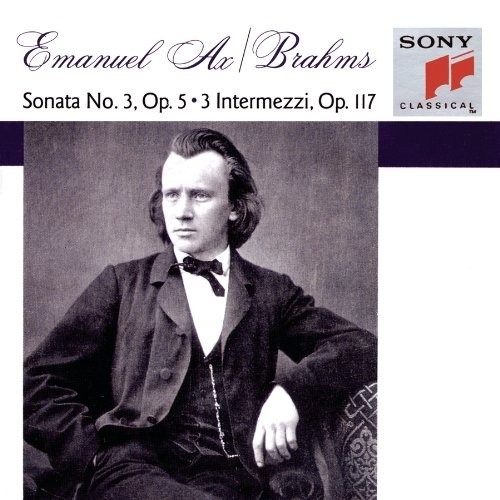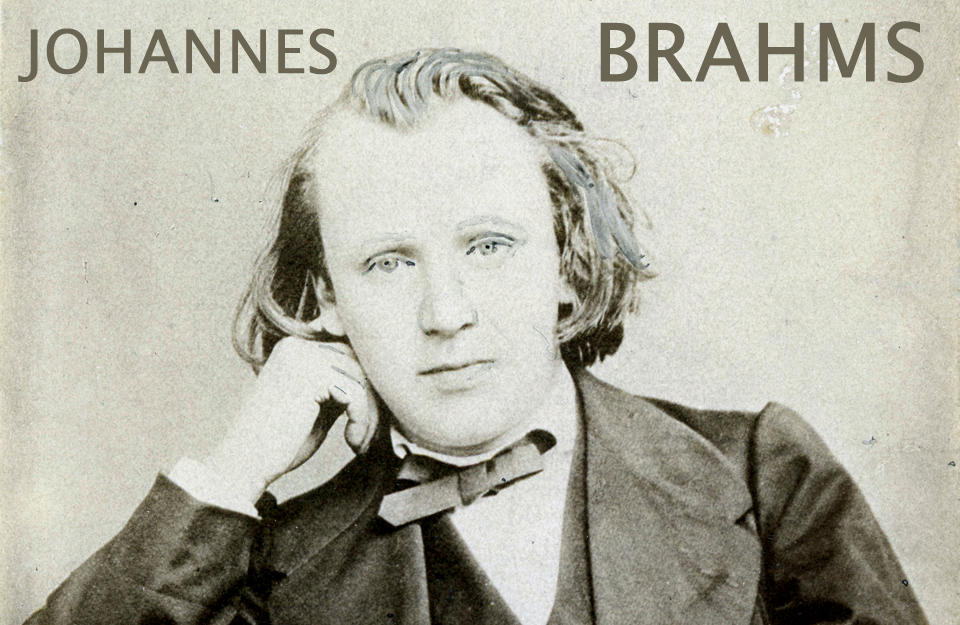Johannes Brahms (1833-1897)
Piano Sonata No. 3 in F Minor, Opus 5
Emanuel Ax, Piano
Recording Location: Henry Wood Hall, London, 1989
ONE-SENTENCE REVIEW:
Emanuel Ax sort of knows what he’s doing… and he’s also sort of a master of liner notes (see below):
ORIGINAL LINER NOTES (By Emanuel Ax):
“I felt certain an individual would suddenly emerge fated to give expression to the times in the highest and most ideal manner, who would achieve mastery not step by step, but at once, springing like Minerva fully armed from the head of Jove. And now here he is, a young man at whose cradle graces and heroes stood watch. His name is Johannes Brahms…”
This was Schumann’s greeting to the twenty-year-old composer who had so impressed both Clara and Robert with his mastery. He had already played movements of his first two piano sonatas for Joseph Joachim, who was equally overwhelmed by the music’s “undreamt-of-originality and power” and by Brahm’s equally mesmerizing playing.
Brahm’s education create the two sides of his nature that make his music unique, personal, and virtually instantly recognizable. His music teacher Edouard Marxsen – an accomplished musician who valued Classical form and logical structure – strongly encouraged Johannes’ interest in composition, as well as accomplishment in virtuoso piano playing.
At the same time, the Romantic movement in literature swept the young man off his feet (he called himself Johannes Kreisler, Junior, after E.T.A. Hoffmann’s mad violinist-hero, and kept a notebook of literary quotations which he named “Young Kreisler’s Treasure”).
This tug between structural balance and Romantic excess delineates one of the cardinal trademarks of Brahm’s music. The other ubiquitous element is rhythmic complexity, especially as exemplified in the hemiola.
Marxsen was instrumental in working with Johannes to strengthen his left-hand independence and sense of cross-rhythm. The contrast of two-against-three and various multiples of this relationship – so integral to Brahm’s dramatic pulse – represents a rhythmic counterpart to the emotional tug of excess and control. The feeling of inevitability in the large structure is always accompanied by a sense of turmoil underneath.
The Sonata No. 3, Opus 5, is unusual for Brahms in two respects: he cast the work in five movements (although one could almost make a case for doing the last three without pause, as part of one large structure); and, at Brahms’ request, a quotation from Sternau was included in the published version at the beginning of the second movement:
Der Abend dammert, das Mondlicht scheint,
Da sind zwei Herzen in Liebe Vereint,
Und halten sich selig umfangen.
(Night falls and the moon shines,
Two loving hearts are united,
Embracing each other blissfully.)
This evocative and touching phrase shows the influence of Romantic literature on Brahms – so striking considering his usual distaste for ascribing literary allusions to his music.
The piece must have been virtually finished by the time Brahms was twenty and had met the Schumanns for the first time – the second and third movements of the work, in fact, were premiered as a unit by Clara Schumann in a concert in Leipzig in 1854: the first performance of the whole Sonata occurred at a musicale in Magdeburg by Hermann Richter.
As usual, Brahms tinkered with the work for a long time, and, also as usual, we have only the final product, along with letters which tell Joachim that he had “substantially altered” the Sonata, and again, that he must “severely review the Sonata, especially the Finale.”
In any case, the final product has become one of the glories of the pianist’s repertoire.
The first movement – Allegro maestoso – isremarkable for its combination of breadth and intensity (in a letter from 1856, Brahms remarked: “NB, It would have been better to mark the first movement Moderato“). The outer limits of the instruments are immediately established in the first five measures; the next episode, with the muted pyramid of hemiolas (cross-rhythms), will act as an animating force throughout the Sonata. There is a remarkable economy of thematic material, as the first theme, the second theme, and, in fact, the transitional material between the two all share the same leap of the fourth.
The second movement, with the Sternau superscription, progresses from the intimate, yearning first theme to the even more hushed and intimate interlude in the sub-dominant which then becomes transformed into a coda of great ecstasy.
Once again, economy of thematic material combines with mastery of form and a prodigious invention to produce the most spontaneous-seeming, sublime effect. The last arpeggio of the movement appears to demand a continuation directly into the passion of the Scherzo, which abruptly breaks the rapturous stillness.
(The Scherzo perhaps testifies to Brahms’ familiarity with the Mendelssohn Piano Trio in C Minor; the theme is a note-for-note quotation of the Trio’s last movement; and Brahms’ C-Minor Piano Quartet seems to owe much of its last movement to the same Trio’s first.)
The Intermezzo, a true intermission – subtitled “Reminiscence” (Ruckblick), goes back to the love theme of the Andante, but this time in the minor mode; one feels very much a sense of loss and desolation.
Its conclusion speaks of tragedy, and the Finale emerges from it almost reluctantly – the pauses and fermatas have the function of a recitative-introduction, and it is an absolute masterstroke that Brahms also makes this quasi-improvisatory rumination the actual theme of the Rondo. With each repetition of the material it becomes stronger, until finally the entire series of hesitations resolves in an accelerated coda. The feeling is one of bursting the bonds which have held “the young eagle” (as Schumann called him) in check, and the final flight to freedom.
The Three Intermezzi, Opus 117, also start with a superscription: the words “Schlaf Sanft, mein Kind” (Sleep, sleep, my child) from a Scottish lullaby. The mood of peace and intimacy of the first gives way in the second and third Intermezzi to ever increasing darkness and despair.
These pieces and, in fact, almost all of the late piano works are more directed toward the individual than toward the audience. Joan Chisell, in her book on Brahms, very plausibly suggests that Brahms’ piano writing in his later years was motivated by the increasing frailty of Clara Schumann, who was so intimately associated with all his creations for the piano. The dimensions, outwardly, have become smaller, but the inner dimensions are greater than ever before – the density of emotion and intellectual stimulation is as great in these works as in anything Brahms or, for that matter, anyone ever penned.
TRACK LISTING:
Piano Sonata No. 3 in F Minor, Opus 5
- Allegro maestoso [10:36]
- Andante [10:44]
- Scherzo [4:36]
- Intermezzo [3:44]
- Finale [7:52]
3 Intermezzi, Opus 117
- No. 1 in E-flat Major [4:39]
- No. 2 in B-flat Minor [4:32]
- No. 3 in C-sharp Minor [6:10]
FINAL THOUGHT:
Just a great recording from one of the great master interpreters of Brahms in history. I couldn’t find a video of him playing it (the link above is over Emanuel Ax playing the 3rd movement in audio only) but here is a great classic performance in by Claudio Arrau from Santiago, Chile in 1984 (though it completely looks like the 1960s).
 Emily Sachs – President – Manka Music Group (A division of Manka Bros. Studios – The World’s Largest Media Company)
Emily Sachs – President – Manka Music Group (A division of Manka Bros. Studios – The World’s Largest Media Company)







